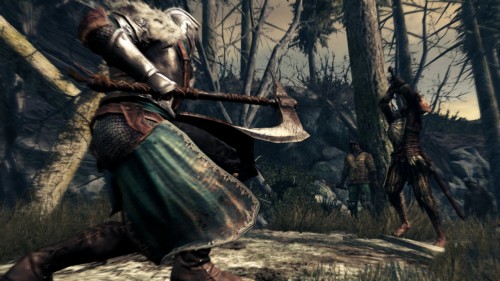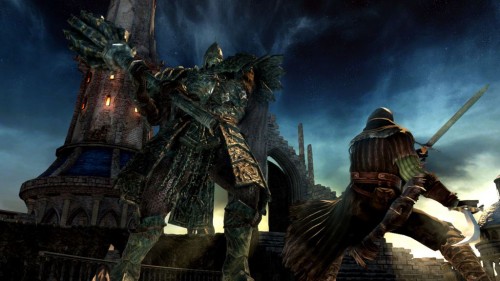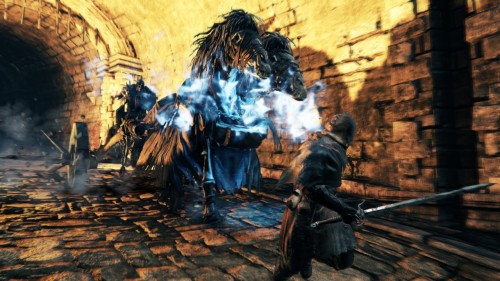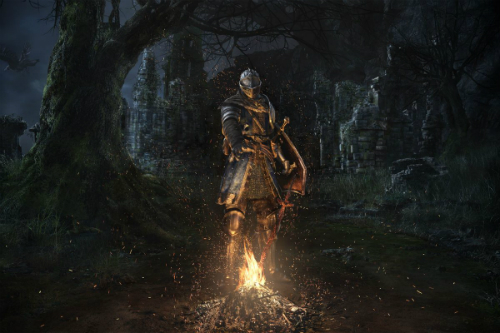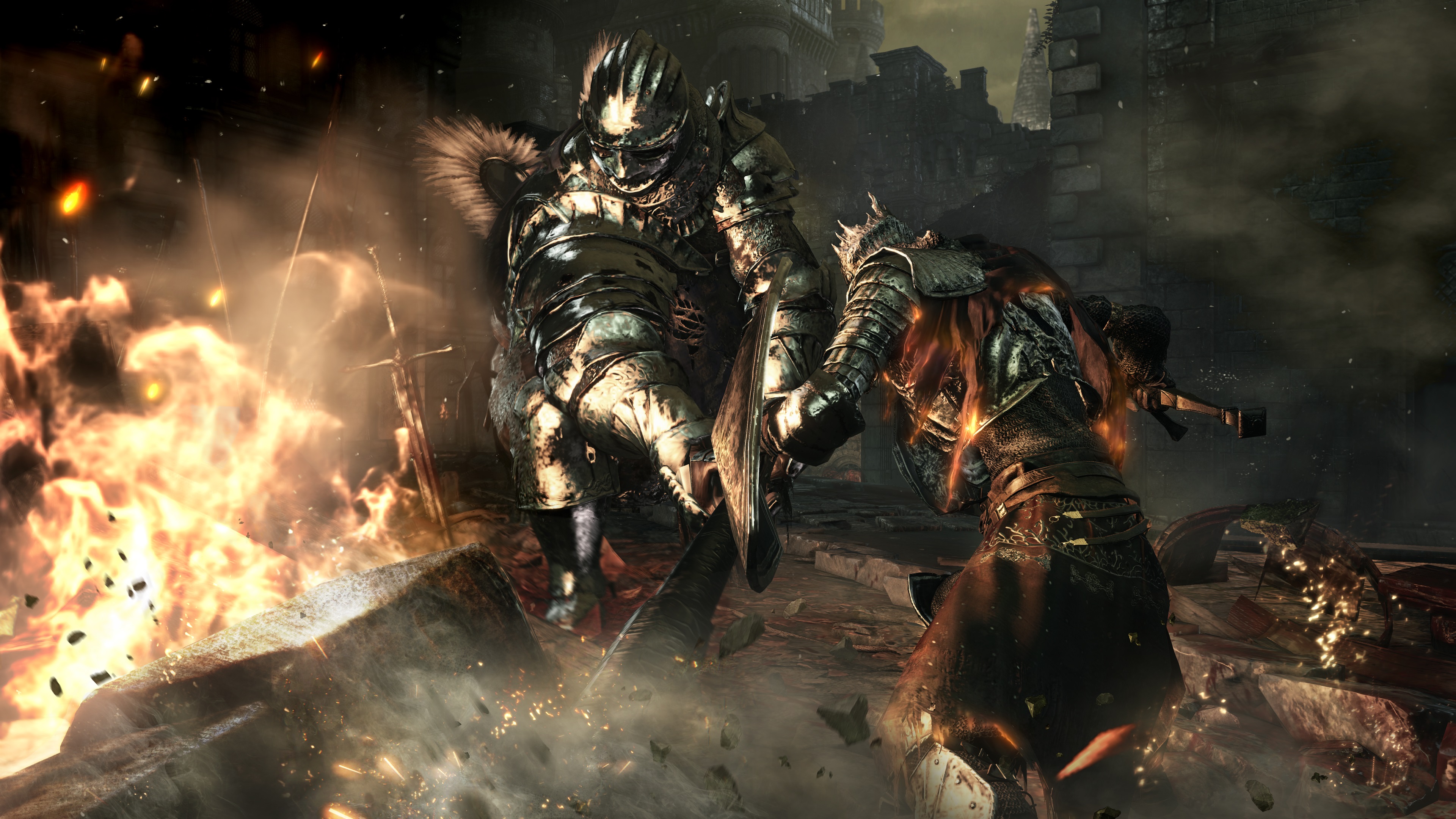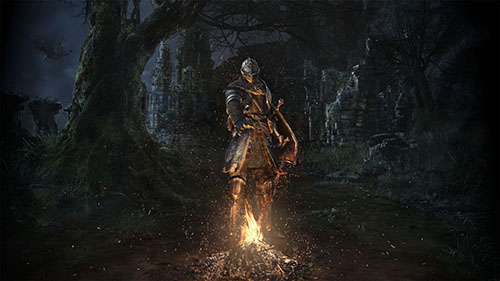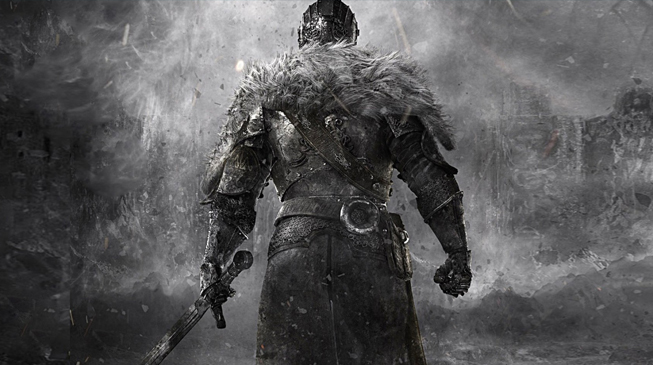
Let’s cut to the chase: I do not consider myself a Souls expert. My experience with Demon’s Souls and Dark Souls varies, and while there’s deep cavern of stat and equipment build fine tuning under the marketed “PREPARE TO DIE” surface, I’ve never felt the urge to dig deep. No, I’m not the kind of player who rolls NG+. No, I don’t grind for hyper rare drops. No, I don’t know what I’m doing most of the time. But in a way, that’s Dark Souls. That’s my Dark Souls. And this is Dark Souls 2.
Familiarity with Dark Souls is valuable to Dark Souls 2. Unlike the leap from Demon’s to Dark (though those were not without obvious similarities), Dark Souls 2 is a direct (though canonically indirect, kinda) sequel to Dark Souls. Those like myself who found themselves easing into Dark more than Demon’s will see that interest translate almost perfectly. There’s a few changes, which I’ll get into shortly, but for most part I could take my learned skills and knowledge of what makes Dark Souls tick put them to immediate use in Dark Souls 2.
This review is based on one playthrough, rolling as a pure melee build, emphasis on sword+shield and mobility (no tanking!). Here’s what I loved, and what I loved less.
The Good:
Much of what works best in Dark Souls 2 carries on from its predecessors. At its heart, Dark Souls 2 is as much a Souls game a you’d expect, and that means you’ve got a highly responsive player skill-based combat system to best use as you crunch through gauntlets of beasts most foul bridging bonfire safe zones. What you loved about Dark Souls in combat play is here, and for most part not only works just as well but better than before. Improvements can be attributed to subtle changes in just that: the attributes, and the diversity. You’ll still need to wiki-or-die what each stat does and the baring it has on weapon/skill proficiency, but Dark Souls 2 cuts a lot of the fluff attributes of the past in favour of skills that serve a purpose. Endurance is still the most important skill for every build, but changes to encumbrance (now multi-tiered, effecting roll weight and distance, with more freedoms on restrictions) and the replacement of resistance with adaptability (a more versatility and interesting stat) makes character building a whole a lot more refined in nuances and less easily wasteful, and at no sacrifice to build diversity.
The other major change is in world structure: the sprawling interconnected labyrinth of Dark Souls is gone…kinda. The world is “connected”, allowing for free form exploration (narrative specific locked areas aside), but linearity has taken a back seat to more unstructured game design. You’ll be able to face a multitude of bosses in an order you see fit, the middle chunk of the game giving you a huge percentage of location and enemy content to digest at your own pace. To curb Dark Souls backtracking From Software has introduced bonfire teleporting. Concerns that this would “casualise” the formula can be cast aside. It’s actually pretty clever how Dark Souls 2 counters this potential accessibility: though plentiful and giving you the freedom to jump around the world, you can no longer level up at any bonfire but must instead return to the main town, forcing you to reset all enemies in the world. Taking cues from Demon’s, you’ll now lose part of your maximum health (up to 50%) whenever you die in hollow form, having to use up resources to revert back to human. All these components come together cleverly, pressuring player skill in new ways that don’t feel cheapened by bonfire teleporting. In the end, teleporting is just quick travel: it curbs a lot of the backtracking fluff in a game that, while open, doesn’t actually need it. I’m not sure it would work well in Dark Souls, but Dark Souls 2 is very much built around this feature, in world structure, bonfire placement, and encounter design.
And naturally encounters are what you’ve come to Dark Souls 2 for. With more bosses than Dark Souls (though only just, if you’re counting the expansion pack), Dark Souls 2 has some gloriously memorable fights across a wide assortment of difficulties. Talking with others, bosses I had a surprisingly easy time with were harder for them, while their builds dominated bosses with which I struggled. This has encouraged me to go back (once the PC release is out) and try out a totally different build: maybe a high-risk-high-reward dual katana build, or perhaps a pure mage.
Finally, and on what has been a slightly controversial point, I found myself continually impressed by the visual presentation. No, it doesn’t look as good as the initial reveal, and Namco/From haven’t been entirely honest with the tech and asset quality in the final build. But it still looks really, really good. From’s artists are magnificent, able to balance dark gothic fantasy with believable, realistic proportions, making those haunting locations and grotesque monstrosities all the more believable and atmospheric. From’s chosen an art style less drab and miserable than Dark Souls; Dark Souls 2 more colourful and fantastical, enemies styled as ancient stone machinations, giant anthropomorphic warriors, and festering undead still clinging to their battle equipment. The vibe is that this was a world both familiar and mysterious, once inhabited and ruled by beings not quite human but not without humanity, a great disaster having left buildings to age and crumble, civilisation to decay, as entropy takes its toll. It’s different, but distinct, and I think that was the right direction in order to aesthetically separate Dark Souls 2 from the last two games.
The Not-so-Good:
Though I’m very much in favour of Dark Souls 2 as an excellent video, reflecting on my experience across the series does expose some grievances I have with From’s change in direction. Little of this has to do with the combat and attribute systems themselves: they could be the best in the series. Instead it has more to do how Dark Souls 2 comes together as a “complete” game, particularly its world structure, and just what you end up remembering most fondly versus other games.
In the grand scheme of things I’m not sure the aforementioned open world structure works as well as From intended, fracturing both the narrative and balance of the game. I found Dark Souls to be meticulously and very intelligently designed in such a way that the illusion of freedom (often no illusion at all) had gentle hands guiding you towards the right objectives. Tiered narrative acts, vague as they may have been, gave you as the player focus on roughly where you needed to go and what to do before exploring the great yonder. This combined with clever boss and enemy placement made it surprisingly easy to gauge whether you were in too deep and needed to turn around, or on the right track, all without the artificially constructed difficulty curve exposing itself. Dark Souls was abstract, but almost only on the surface. Underneath beat the heart of a very meticulously and cleverly designed game world, one tricking you into the illusion of abstract, aimless design.
Dark Soul 2 on the other hand almost totally personifies “abstract”. There’s plot, but it’s vague and far less directed than Dark Souls. This is probably in part to the aforementioned bulk of open ended gameplay. I often had no idea where I was going or what I was doing, if there was a “right” thing to do at all, and even when discovering my goal it was largely inconsequential and aimless. Dark Souls 2‘s world is a big open molasses of boss encounters, and all you need to know is that you’ll wander it killing bosses. Even then, the world construction is illogical at best. Locations are beautiful and magnificent as stand-alone structures, but connected? There’s some bizarrely illogical art shifts and terrain displacements as you move from one zone to the next that makes Dark Souls 2 almost feel like Demon’s Souls trying to be Dark Souls. I really loved the location diversity here, but as someone who loved Dark Souls sense of cohesion in map and world structure, this feels a bit like a disorientated backwards step. Dark Souls 2 is a lot of awesome memorable fragments, but not really a big cohesive story or world map.
Open play structure skewers the balance a bit, too. The noted Dark Souls guidance in design is mostly gone. Tackling a large number of bosses in non-sequential order makes it difficult to gauge if the fight is hard because you suck, or if you should be fighting another battle elsewhere. On a number of occasions I learned of a ridiculously obtusely hidden path to a key location later than the game intended, fighting bosses and enemies surprisingly below my character level. Dark Souls 2’s non-linearity makes it an easier game to break in balance, and far more confusing to find yourself on the right track. And though I liked the fights as a whole, I will say that more than Dark Souls this game is composed of a lot of similar boss designs. Similar attacks, similar weaknesses, and similar structure. A lot of bosses are anthropomorphic (or semi-anthropomorphic), reliant on the same style of openly telegraphed heavy/light attacks. I would have liked a bit more abstract boss style and attack diversity, forcing me to re-strategise, like in Dark Souls.
And finally, Dark Souls 2 isn’t without its technical issues. Which is…about on par for the Souls series on console. Framerate fluctuates, but it’s stable. Lag is the main issue, online performance fluctuating, and I feel there’s ever-so-slight delay in controls. Dark Souls 2 is clearly a game wrestling with its tech and console hardware, often taking 20 – 30 second to load between bonfires, and audio samples failing to play on cue (like hitting an enemy) as the engine plays catch up. It looks great, but more polish could be done, hopefully in the form of patches. Especially towards one late game area ripe with awful enemy pop-in.
Verdict:
Dark Souls 2 is Dark Souls. More Dark Souls, with changes you will appreciate and fights you will remember. It’ll grab you by the balls and have you hooked from start to finish, and then into NG+ if you’re into that kind of thing.
For me, parts of the game are better than Dark Souls, notably the attributes and equipment. Specing my character just made more sense, and I felt like the reasoning behind stats is more logical. And you’ve got no concessions to build diversity, instead expansion: builds impossible in Dark Souls now viable and unique in Dark Souls 2. I look forward to expert players finely tuning super builds over the next few months, discovering little secrets and tricks to maximise damage dealt and reduce damage taken.
But other parts I’m less fond of. I do miss the giant, connected world of Dark Souls. What’s here is good, but vague, fragmented, and abstract. And not necessarily cleverly abstract. Some “solutions” to puzzles, secrets, and fights are needlessly convoluted or illogical. This is a Souls game, so I guess that’s to be expected, but while community, secrets, and vague information is very important to my immersion in these games, I think a line can be drawn when it’s abstract for the sake of abstract. If I’m reading the solution in plain text on a forum my experience isn’t “enhanced”, it’s just an answer that could have been better integrated into the game. As could a more cohesive, driven game world that doesn’t have you aimlessly wandering for most of the story.
All of this is far from a deal breaker though, and I know for a fact some will love the way Dark Souls 2 is structured. For some it’ll be that perfect balance between Demon’s and Dark. And regardless of where you sit, the fundamentals if Souls is intact. And since those fundamentals alone make for a great game, Dark Souls 2 is just that: a fantastic, brutal, and enduring action adventure you wont want to put down until the credits roll.
If you’d like to learn a bit more about how the Dark Souls franchise plays, and the big changes introduced in Dark Souls 2, you can enjoy watching the official “How To Play” video above.
Brutal, but fair | Gorgeous art | Further refined game systems
Aimless narrative | Incohesive map | Technical quirks

